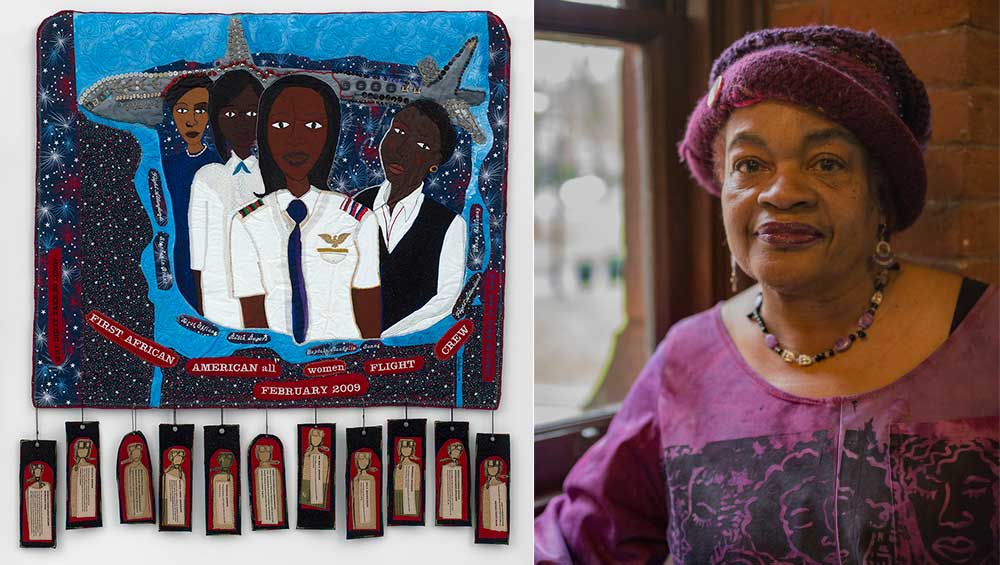
Left: Dindga McCannon. Why Did it Take So Long? (Black Women in Aviation), 2012. Mixed media on canvas, 149.9 x 149.9 cm (59 x 59 in). Right: Dindga McCannon. Courtesy the artist, Pippy Houldsworth Gallery, London, and Fridman Gallery, New York.
by VERONICA SIMPSON
Dindga McCannon, who was born in 1947 in New York City, has dedicated her life and work to the celebration of black culture - and the power, creativity and resilience of black women in particular - in exuberant works that range from textiles across prints to sculpture. She has played a vital part as an artist and teacher in activist and feminist communities in Harlem and the Bronx, where she was raised, and Philadelphia, where she now lives. She is hugely celebrated within those communities and within the wider fibre arts arena, so it is a shock to find that only now, in her mid-70s, is she having her first European solo show, at Pippy Houldsworth Gallery in London. Perhaps more shocking is that her first US solo show was only last year (In Plain Sight, at the Fridman Gallery, New York).
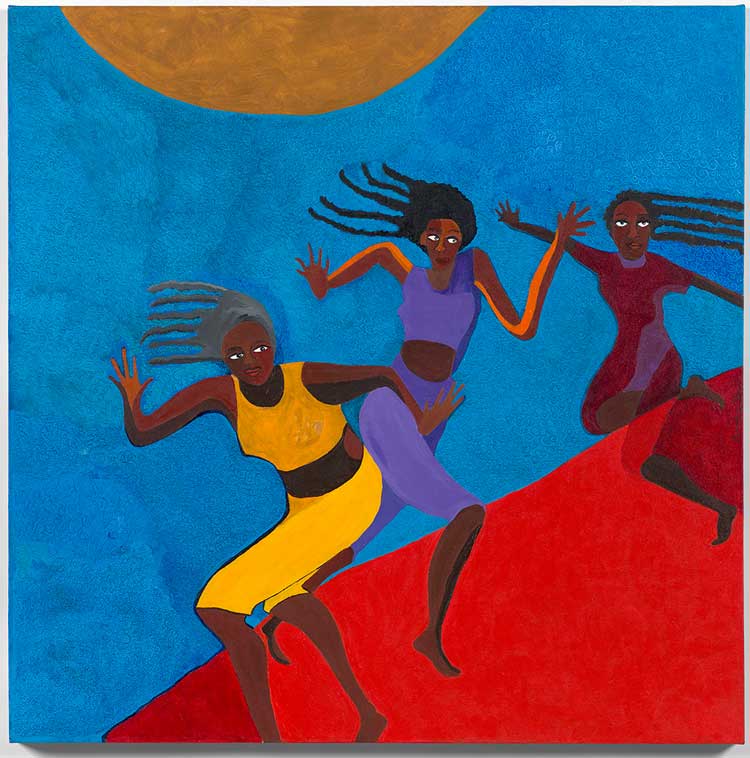
Dindga McCannon. Dancers #4, 2020. Oil on canvas, 101.6 x 101.6 cm (40 x 40 in). Courtesy the artist, Pippy Houldsworth Gallery, London, and Fridman Gallery, New York.
Although she was discouraged from pursuing art when, aged 10, she first announced her intention, she was allowed to go to a school where fashion design was studied. This led to her early discovery of the power of fabric, colour and texture. Graduating at 17, she got a job as a volunteer teacher and attended night classes at the City College of New York. During this time, she discovered the Black Arts Movement, which made art that put black people and their experiences at its centre. With some of its members, she went on to form the Weusi Artist Collective, and immersed herself in studying, learning what she could, and getting involved in the vibrant activist movements across art, politics, music and literature. She left City College after two years and went to the Art Students League of New York in Manhattan, where tutors included the artists Jacob Lawrence and Richard Mayhew.
Feminism became a major focus of her life and work in the 1970s and she started the collective Where We At, Black Women Artists, along with Faith Ringgold and Kay Brown. Her practice – still largely painting and printmaking – expanded to include quilting at this point. This was further encouraged in 1998 by the reaction to her first quilt in a museum, shown as part of Spirits of the Cloth: Contemporary African American quilts at the American Craft Museum in New York.
She has carried on teaching, making and exhibiting, despite the contemporary art world’s slowness to catch up with her. There is work of hers in many US collections, including the Brooklyn Museum, the Studio Museum in Harlem, the Schomburg Center for Research in Black Culture, and Michigan State University. Her work appeared recently in We Wanted a Revolution: Black Radical Women, 1965-85, organised by the Brooklyn Museum; and Black Power at the National Civil Rights Museum, Memphis, Tennessee.
Studio spoke with Dindga in person, at the Pippy Houldsworth Gallery, as her show was being prepared.
Veronica Simpson: What has it been like to become celebrated by the mainstream art world in later life, when you have already been at the centre of a vibrant creative community for 50 years, supporting other artists and being recognised for your work. As Michelle Bishop, founder and director of Harlem Needle Arts, said, when the New York galleries “discovered” you, you were “already famous”.
Dindga McCannon. Well, I’ll tell you a couple of things. No 1, when I go to a store like I did this morning, they still follow you around the store. It’s part of being African American or a black person in the world. It’s been kind of interesting, it’s definitely been great financially. I’ve finally become financially stable, which has become a whole different story in itself. Then, also, it’s a little weird in a sense because I’ve been working all these years. I’ve always been famous in my own community. Now it extends outwards, which pretty much ensures that I’ll be able to stay in the studio for the rest of my life. But it’s great because I can support other artists. I’ve been able to make really good things happen for my children, who all these years, they were the ones who used to travel with me from one end of America to the other with all my stuff.
But the main emphasis is that I’m able to work, free and unhindered by financial issues. I don’t have any limits. Although, not having money never really stopped me from creating what I wanted. Sometimes, I’d create work for themed exhibitions. I don’t have to do that any more, unless I choose to.
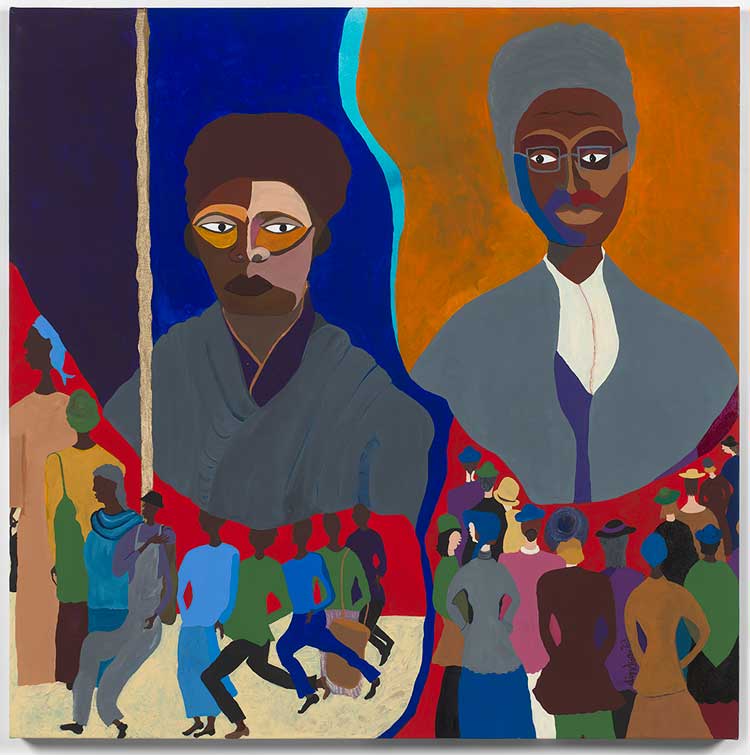
Dindga McCannon. Harriet Tubman and Sojourner Truth - Warriors, 2021. Acrylic on canvas, 121.9 x 121.9 cm (48 x 48 in). Courtesy the artist, Pippy Houldsworth Gallery, London, and Fridman Gallery, New York.
VS: Being able to say no - isn’t that a wonderful place to be, at any point of your life?
DM: Yeaahhh! I work in a lot of different mediums. Sometimes, to bring in money, I would make wearable art. Or I would do themed exhibitions. I also taught for many years. I love teaching. I love sharing the joy in finding and being able to create. But if you’re going to be a good teacher, it takes a lot of time and energy. And now I’m able to create whatever comes to mind.
VS: I always think it is interesting when artists don’t go straight to art school (or don’t go at all). You had to find a way to make what you wanted before you went to study art, and I wonder to what extent that is part of what has empowered you to stay true to your passions – because you had already found your themes before some teacher told you that was not allowed, or said that textiles could not be considered fine art.
DM: I didn’t go to school, and one of the reasons was because of that. In the 1960s, I went to City College, and they really weren’t feeling me doing images of black people. That was the first thing. So, I said, you know, I have to fight on so many levels. I was a single parent, I was an artist, I was a woman – there were so many fights I had to deal with. I decided, wow, I’m not going to fight about my subject matter. So, I said I think I should take another route. That’s how I ended up at the Art Students League, because you could choose who you wanted to work with. I chose those men because they were African American, and they definitely saw my vision and were able to encourage it. The rest of my education has been workshops, classes and a lot of books. I would read books on techniques, then I’d go into the studio and mess up a whole bunch of stuff until I got it right. That was my education. You find your way through years and years of practice and the process of working, and eventually you find your own voice. Basically, you have to do the work. And you have to be able to sacrifice everything.
I’ve always equated my relationship with art with a long love affair. You know how you would do outrageous things for love, all throughout your life? This is how I feel about art. I’ve done some outrageous stuff, but, man, I’m still in love.
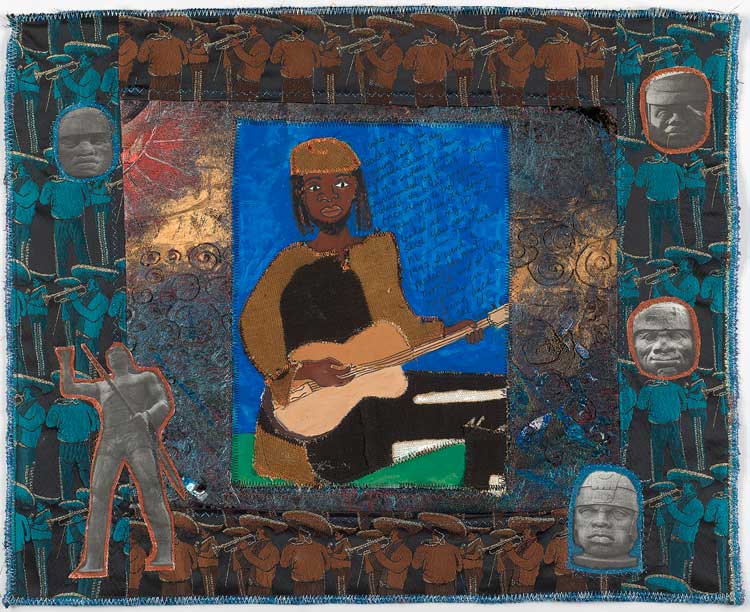
Dindga McCannon. I Ain't Never Coming Back to the U.S.! Ever! to Bro. Yekk, 2016. Mixed media quilt, 44.5 x 54.6 cm (17 1/2 x 21 1/2 in). Courtesy the artist, Pippy Houldsworth Gallery, London, and Fridman Gallery, New York.
VS: That is such a great way of looking at it. A New York Times interview said your work was “hard to categorise” because you work across so many media. But now that we are looking at those categories with fresh eyes, from the topics and the materials, and the people who get to make art, it is great to see that the art world has expanded (at last) to include all of that. Did those former prejudices impact much on your practice?
DM: In the world I have existed in, it wasn’t such an issue. But in the greater art world, they didn’t want textiles. They couldn’t figure it out - was it art? Was it women’s work? I could never understand this, because I would go to the George R Brown Convention Center in Houston and they have one of the largest quilt festivals in the world. And they have thousands of quilts. Thousands of vendors selling stuff that you can use to make quilts. How is this not a major art form?
I think, because I wasn’t involved in the greater art world, [their judgment] didn’t affect me so much. I’ve always had faith in what I was doing, though it’s good to have a wider audience, I tell you that.
VS: You have been active within some of the most vibrant, inspiring communities within the American art scene, from the 60s activists, the 70s feminists, to the present day. Do you feel that is part of your legacy, that you are carrying that with you?
DM: Most definitely. And because I have lived that and am continuing to live it, that inspires other young artists, and other women who dream of being an artist someday, but they’re always told, you’re going to starve, you can’t make any money. Which is what I was told, and I promptly ignored it because I’m hard-headed. And that categorising thing, I never wanted to be categorised. The thing with me and mediums, as a creative person, I didn’t want to be stuck as a painter or stuck as a sculptor. Some artists don’t have a problem with that. But there’s so much to explore artistically and I didn’t want to cut myself off. It did create problems because a gallery wants you to have some kind of consistent flow of work, which is probably one of the reasons why I never had a gallery until a couple of years ago. But for myself, as an artist, I just want a bigger playing field.
I think, one thing about artists is that we are usually pioneers. We have visions that the average person might not have. Now we’re at a point where those visions are celebrated. Another thing is, I’m really glad to be living through all of this. A lot of artists died in obscurity, died without having major sales and that’s sad. I got very blessed and lucky, plus I earned it, because I’ve worked hard all these years.

Dindga McCannon. Smoking Man, 1967. Watercolour on paper, 45.7 x 30.5 cm (18 x 12 in). Courtesy the artist, Pippy Houldsworth Gallery, London, and Fridman Gallery, New York.
VS. Apparently, you have now been able to rent yourself a studio. What can you do with the resources and recognition being made available that you could not envisage before?
DM: I have one assistant who comes in as and when needed, but most of the work is done by myself. I’m working through the Robert Blackburn Printmaking Workshop. I printed there in the 70s, 80s and 90s. I have a fellowship there now, and they are my assistants, in a way: they helped me take off in my printmaking career. And the first thing we did was editions.
VS. I would love to talk to you about the use of colour in your work. You once said your portrayals are not “one-to-one portraits but interpretations of the spirit as you feel it”. Is this, and does it remain, intuitive, or is there some kind of recognisable language you feel your work has developed that indicates a system to the colours, rhythms, compositions and materials you use?
DM: I have no system whatsoever. I’ve noted I’ve always had a problem with my use of colours. In the early days, I was training as an oil painter, and one day I woke up and acrylics had come out, and I gravitated towards those because the colours were outstandingly bright and bold. My use of colour is totally intuitive. It’s a cultural thing as well. Europeans tend to like very muted, soft, pastel colours, whereas people of African descent are usually on the bright side. I remember coming back from trips and people would say, why are you using those bright colours? And I would tell them, when I go to Africa, the women in the morning dress up like they’re going out at night.
In textiles, we have access to all these different patterns and colours, and that’s what makes us different. Me, personally. I make [and dye] a lot of my own fabrics. I’m not dependent on other people’s fabrics, though I collect fabrics like crazy. It kind of works together, my fabrics, plus other manufactured fabrics, and handmade fabrics from other people. It gives you a really wide palette colour-wise, and texture-wise.
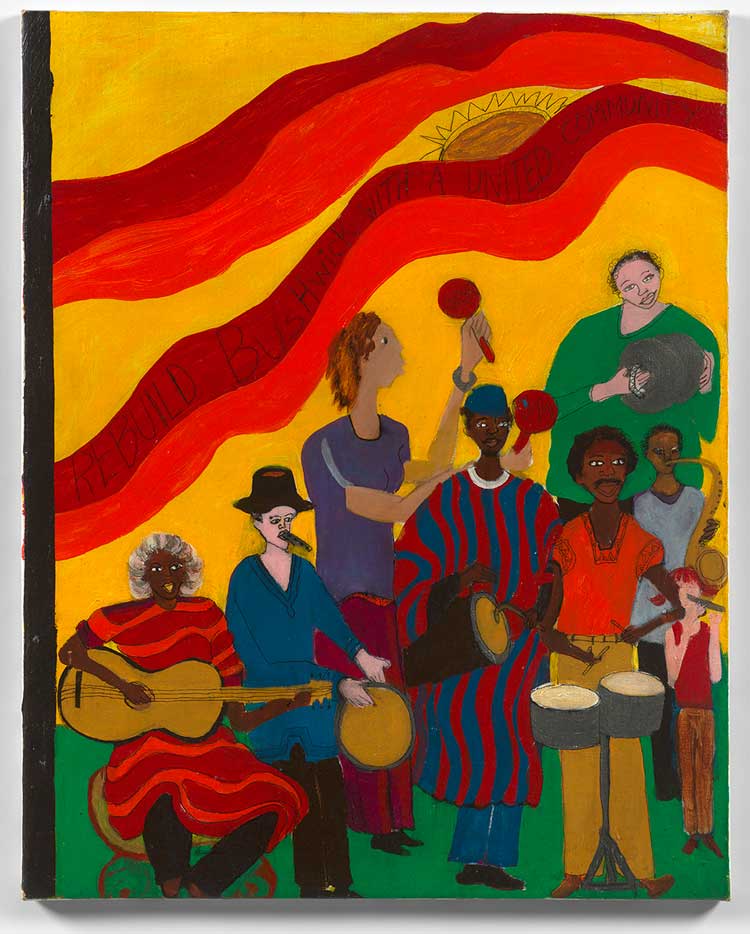
Dindga McCannon. The First Marquet for the Mural A United Community - Bushwick Brooklyn, 1979. Acrylic on canvas, 76.5 x 61 cm. Courtesy the artist, Pippy Houldsworth Gallery, London, and Fridman Gallery, New York.
VS: You have said that music is a huge inspiration. How do you use that inspiration?
DM: It’s not the music itself, which of course is wonderful and uplifting, but it’s the process. I started with jazz musicians, because, when I was young, I had a shop and when I’d finish working in the shop, around midnight, there weren’t many things I could do, so I’d go to jazz clubs, and seeing those musicians and the interplay of instruments and human beings was so inspiring, visually.
Fast forward to around 2000, I found out that there were hundreds of all-women bands in the 20s, 30s and 40s. I thought: I have to tell everyone about this. The Blues Queens piece that’s going to Frieze, I was inspired to do that piece by knowing that these black women, in the 1920s, ran their own businesses, ran their own careers, made amazing music and wore clothes to die for. Once I found out about them, I started listening to the lyrics. I thought: how did they get away with those lyrics for those times? And a lot of the women were gay and there were many prejudices they were dealing with - prejudice as a black person, as a woman, and gay and then being a female musician. They have all these things going against them, but they still thrive and survive and make beautiful art.
VS: Do you feel encouraged by the shifts we are seeing in visual culture, with many other voices now being visible in contemporary art, and diversity and female lives and issues celebrated by the mainstream, including movies and television?
DM: Very much so. My theme is never give up. So, I’m beginning to see a whole new world kind of emerge, something that we’ve been waiting for at least 50 years. It’s wonderful. I see artists who are half my age having sustainable careers, and who are basically studio artists. That alone is empowering. And seeing exhibitions everywhere of women, and people of colour, and we’re all being celebrated as we should have been all these years. Finally! And it’s wonderful to have lived this long to see this happen.
VS: Do you still teach? I have a lovely quote from you about teaching where you say that art can be used as a tool for healing and discovery.
DM: Yeah, I’ve had two teaching lives. One was with a non-profit, that meant I worked in shelters, prisons and day care centres. In that particular avenue, I found that being an artist was kind of empowering, because I didn’t treat human beings like someone who was going to school. I learned to deal with them as human beings. Everyone has some kind of talent; they just don’t know what it is yet. Through art, if you can show someone how to create something, it gives them empowerment. This made my classes very popular: they could come in and pursue whatever their interests were. No rules.
Then my other teaching life is teaching other artists out of my studio, which is wonderful. I do it selectively. And that’s great because I’m able to take all the things, the techniques that I’ve learned and empower them and take whatever level of creativity they’re on and add to their repertoire.
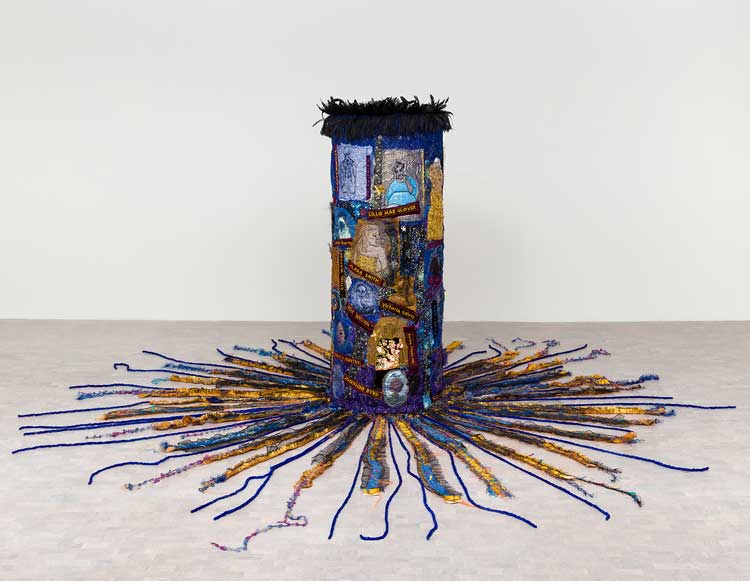
Dindga McCannon. Blues Queens, 2021. Mixed media quilt, 138 x 300 cm (54 ⅜ x 118 ⅛ in). Courtesy the artist, Pippy Houldsworth Gallery, London, and Fridman Gallery, New York.
VS: Which favourite or new works are you showing here in London?
DM: The Blues Queens piece, that’s my favourite. The sculptural part of me was able to come up with the Blues Queens. That’s being shown at Frieze.
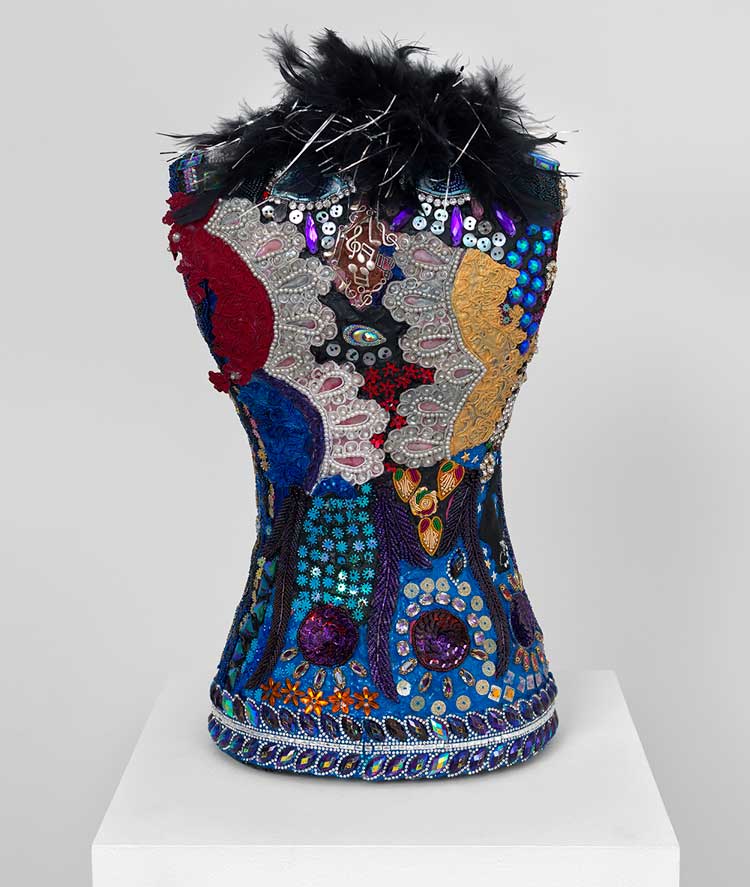
Dindga McCannon. Carnival #1, 2022. Mixed media on mannequin, 68.6 x 45.7 x 45.7 cm (27 x 18 x 18 in). Courtesy the artist, Pippy Houldsworth Gallery, London, and Fridman Gallery, New York.
And this one is my latest piece (Carnival #1, 2022). It’s a whole departure from everything else I’ve done. This piece was sort of inspired by going to the Venice Biennale [this year]. I noticed all these costume shops around the city. I asked, why is this? Then when I got home, I found out that carnival, which in my world was usually a West Indian celebration, actually started in Venice in the 1400s. And it spread around the world. I guess I had this form left over from Halloween and one day I started putting sparkly things on it and I just kept going.
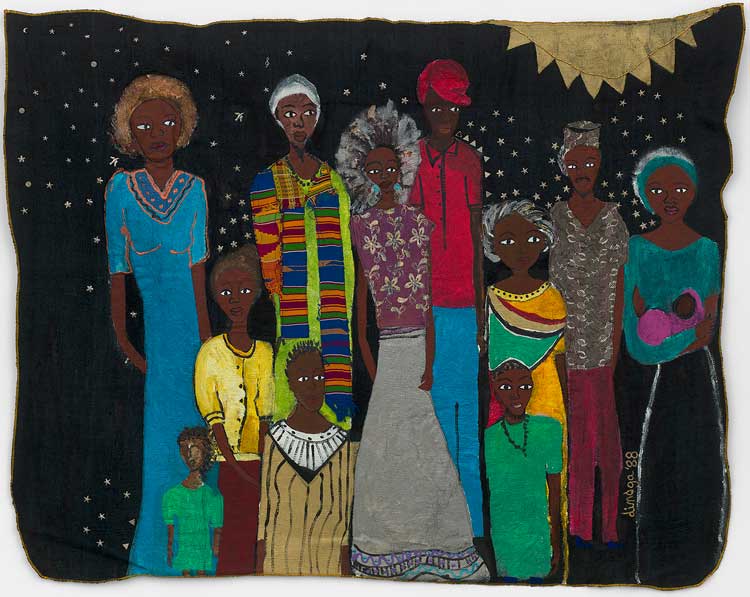
Dindga McCannon. Family #1, 1988. Acrylic on silk, 124.5 x 157.5 cm (49 x 62 in). Courtesy the artist, Pippy Houldsworth Gallery, London, and Fridman Gallery, New York.
VS: Can you tell us a little more about the work that’s on show in the gallery?
DM: This is probably the earliest piece, one that has sat in my basement folded up: Family #1 (1988). I’ve also got The Wedding Party #1 (1999) and Wedding Party #2 (2000) [not shown]. These are works that are a celebration of the family and the people and the neighbourhoods I grew up in.
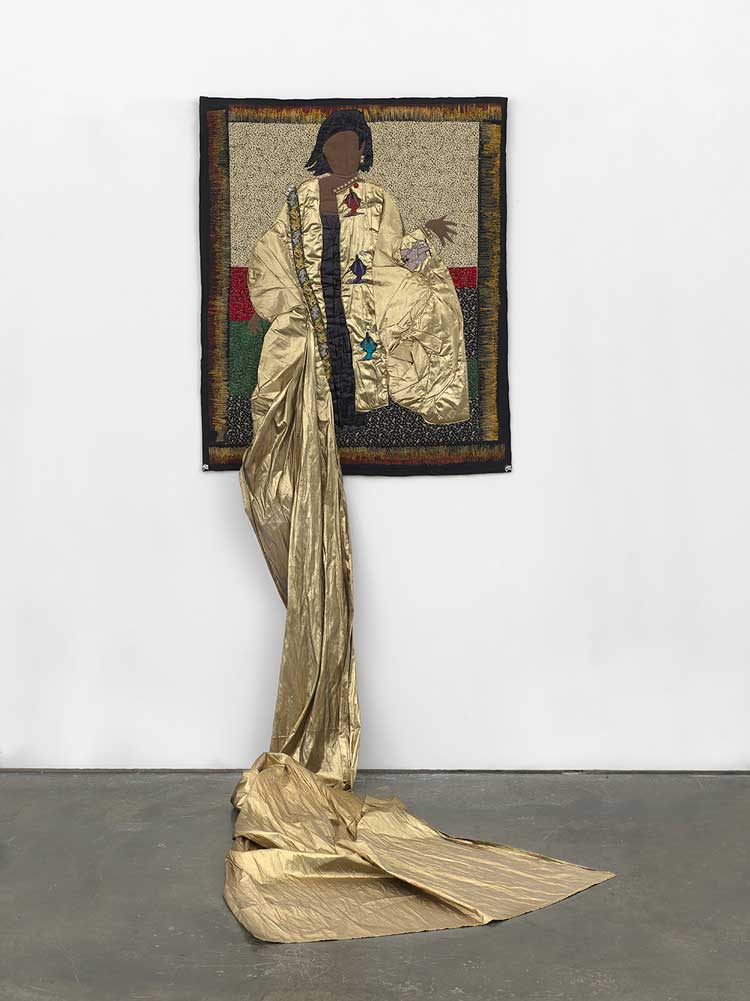
Dindga McCannon. Bessie's Song, 2003. Appliqué and machine quilted cottons, gold lame, vintage beaded trim, embroidered patches, glass beads, metallic threads, 228.6 x 91.4 cm (90 x 36 in). Courtesy the artist, Pippy Houldsworth Gallery, London, and Fridman Gallery, New York.
This one is called Bessie’s Song (2003) [inspired by the blues singer Bessie Smith]. I know, it doesn’t look anything at all like Bessie Smith. But the thing that got me inspired by the blues women was their costume and clothing. It was bright, it was outrageous, it was in-your-face. When it’s on the wall this (golden fabric) cascades and you can do all kinds of things with it.

Dindga McCannon. Words Form the Threads of Our Experiences, 2015. Mixed media on quilt, 83.8 x 55.9 cm (33 x 22 in). Courtesy the artist, Pippy Houldsworth Gallery, London, and Fridman Gallery, New York.
This piece, Words from the Threads of Our Experiences (2015), I created for an exhibition, and it says be careful what comes out of your mouth, because words are powerful.
_2012.jpg)
Dindga McCannon. Why Did it Take So Long? (Black Women in Aviation), 2012. Mixed media on canvas, 149.9 x 149.9 cm (59 x 59 in). Courtesy the artist, Pippy Houldsworth Gallery, London, and Fridman Gallery, New York.
And this one, Why Did It Take So Long (Black Women in Aviation) (2012), is about the first all-female, all-black American flight crew. I chose to do this part of our history because I found it interesting. It didn’t happen until 2009 – Why did it take so long? And these (portraits on tags hanging along the bottom of the main quilt) are a homage to some of the people who were in aviation who preceded them. My theory is that, because these people existed, the door opened.
VS: Persistence is so important for an artist – for any pioneers.
DM: I’m very persistent. I’ve always been the same woman that you see here. I was the same at 23. The world didn’t necessarily like that, but I didn’t care, because I have a different sense of self that wouldn’t allow me to be intimidated by other peoples’ opinions.
• Dindga! is at Pippy Houldsworth Gallery, London, until 12 November 2022.
Click on the pictures below to enlarge